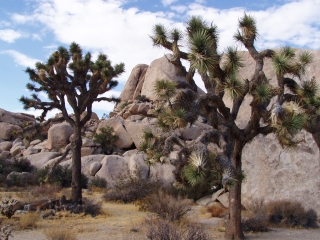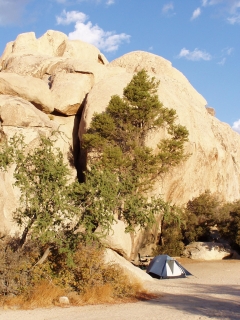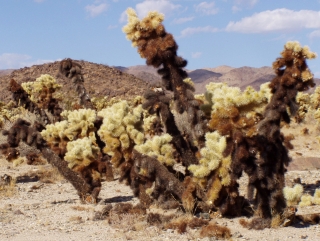near Twentynine Palms, Calif.
NPS Website; Local Website

WHAT IS IT?
A confluence of the Mojave and Colorado Deserts distinguished throughout by a few palm oases. The hotter and drier Colorado Desert (a subsection of the Sonoran Desert) is a stark environ, noted by jumping cholla cacti and ocotillo. The higher climate of the Mojave Desert, the Site’s western half, boasts groves of the Park’s famous namesake, the Joshua tree. The Mojave also contains the Park’s geological wonders, whimsically stacked boulders that have made Joshua Tree NP a world-class rock climbing destination.
BEAUTY (8/10)
Joshua Tree NP is one of those places where every vista, every tree and every rock feel as if they would compose a beautiful picture. The scenery is rugged but not forbidding, awesome but not overwhelming, otherworldly but tangible, stark but full of life, alien but familiar.
HISTORICAL INTEREST (2/10)
Remnants of mines, desert ranches and 1930’s life dot the Park’s landscape. All attempts to live in this arid desert environment have failed.
CROWDS (6/10)
There were not a lot of people at Joshua Tree NP during our October mid-week visit. We expected the Park and its campsites to be full. Perhaps the weekends are different.
EASE OF USE/ACCESS (4/5)
The Park is 140 miles east of downtown Los Angeles, its southern entrance easily located just off Interstate 10. Access to the more popular, more boulderized north is through the towns of Joshua Tree and Twentynine Palms, just off California Route 62. The town of Joshua Tree is about 40 miles north of the golfing mecca, Palm Springs.
The Oasis Visitor Center is relatively new. The bookstore seems to be fully stocked with a not-bad selection. Stuffed scorpions, snakes and bats (how cuddly!) were among the gifts you can purchase. Cool magnets, shot glasses and key chains stamped with the distinctive outline of Joshua trees are for sale here.
COSTS (3/5)
Entrance is $10 per vehicle or $5 per person on foot. Given that the campsites are all 10+ miles from the entrances through desert, we are not sure who would ever enter on foot. Entry is free with the National Parks Pass. Campsites are numerous, gorgeous and cheap. They are so nice that some car company is currently running an SUV commercial set in one. There are 8 campgrounds and nearly 500 campsites. Sites at Black Rock and Indian Cove can be reserved in advance and are $10. All other campgrounds in the north cost $5 and are available first-come, first-served.
RANGER/GUIDE TO TOURIST RATIO (1/5)
Indian Cove Entrance Station: closed. Cottonwood Visitor Center: one Ranger. Park Interior: No Rangers. Oasis Visitor Center: Two Rangers complaining about the staff shortages.
Even though the high season for the desert climes of Joshua Tree NP are October through April, the seasonal staff is on board only from May though September leaving the permanent staff to deal with the larger crowds. The NPS treats Joshua Tree NP just as it does all other Parks even though it flies in the face of all visitation statistics and basic logic. The Rangers at Oasis were so angry about their loss of help that they forgot to help us.
See the Best of October for our conversational exchange. We got so little information from the Park Rangers that we moved on and asked two Joshua Tree (town) store owners for assistance. “How long should we stay in the Park?” “Well, I like it here. I came, decided to stay and have been here 15 fifteen years. Maybe it will be the same for you. Who knows?” They did proceed to tell us which campsites they preferred and which hikes were “can’t miss”.
TOURS/CLASSES (4/10)
The exhibits in the small museum section are still being constructed. The ones that do exist pay tribute to Ms. Minerva Hamilton Hoyt, “Apostle of the Cacti,” desert lover and conservationist who worked to preserve Joshua Tree NP and other desert environs. Everything in the Visitor Center was geared towards improving the image of the desert. It may look like a foreboding place of death, but it’s really not.
We agree. Joshua Tree NP is a beautiful place. Other than the new Oasis VC on the way in and the much older displays at Cottonwood VC on the way out, we had little opportunity for guided tours or classes inside the park. There are Ranger talks on weekends when staffing allows and occasional tours of the Desert Queen Ranch. A Ranch tour costs $5 a person.
Several self-guided nature trails were short drives from our campsites. More dot Pinto Basin Road, the main paved road through the park. Some had guides at the trailheads, others interpretive panels to point out flora that are not Joshua trees. We particularly enjoyed the walk through the cholla cacti field. No pets allowed here, for obvious reasons.
Joshua Tree NP is one big playground. Every rock is a climbing conquest. Every boulder beckons. You climb, hike and mountain bike almost anywhere you would like. Just stay clear of the jumping cholla cacti.
WOULD WE RECOMMEND? (7/10)
If you are a rock climber, visiting Joshua Tree NP is a no brainer. In fact, you have probably already been here. As for the rest of us, the Park has a lot to offer, you just have to search it out. Except for the Keys View overlook, the car-related vistas and driving tours are underwhelming at best. You need to go on the short, easy nature hikes. Get away from the rush and slow down. Who knows, you might even find yourself scurrying up 50-foot boulders. We did.
Joshua Tree NP also offers quiet rewards and solitude. We would especially recommend a night at one of the Park’s tremendous campsites. The stars are luminous and most sites are secluded among imposing rock formations. You also get respite from the often-oppressive summer temperatures. It is the desert.
TOTAL 46/80
www.usa-c2c.com
© 2004-06